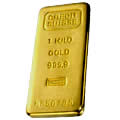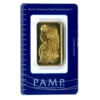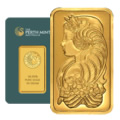Sizes Of Bars
As a symbol of money gold bars take some beating. Hollywood shows stacks of big yellow metal bricks at least as often as chests of pirate treasure and the message is similar – “This is what wealth looks like.” For once this isn’t just artistic license either. Large scale gold trading between banks, governments and major bullion traders is based around gold bars. They’re also a popular option with metals investors for their high purity and low premium over spot price.
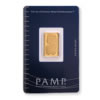
In the movies gold bars are usually shown as large ingots about a foot long. These are dramatic looking, but anyone who knows how heavy gold is must have some doubts about how practical they would be. So what sizes do gold bars really come in, and what are the best choices for you as an investor who wants to add gold to your portfolio?
In fact gold bars can come in pretty much any size somebody wants to make. The largest in the world was cast by Mitsubishi in 2005 and is on display at Japan’s Toi gold mine. It’s 18 inches long and weighs 250 kilograms, or just over 550 pounds. At current prices its gold content is worth nearly $11 million, plus a premium for its status as the largest bar. At the other end of the scale are tiny bars weighing a gram that sell for not much over $50.
The jack of all trades of the gold bullion market is what’s usually called the Good Delivery bar after a set of standards issued by the London Bullion Market Association. The standards cover the size and weight of the bars, certification of sellers and approved storage locations, making these bars a very reliable investment. As a result they’re the bullion of choice for the major markets, central banks, top level traders and even organizations like the International Monetary Fund. These bars are what’s kept in Fort Knox. And, in fact, they’re very much like those big bars in the movies. Good Delivery bars are usually between 8.5 and 12 inches long, 2 to 3.5 inches wide, 1 to 2 inches thick and must weigh between 350 and 400 troy ounces – 24 to 30 pounds. They must be at least 99.5 per cent pure gold and there are detailed rules on their markings – each bar is stamped with the maker’s hallmark, purity, weight, year of manufacture and a unique serial number. However with a price of around half a million dollars per bar they’re out of reach of most private investors. They also have to be kept in a LMBA-approved vault; if they’re not they lose their Good Delivery status and their resale value drops.
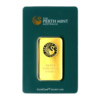
A good alternative that many investors go for is the kilo bar, a loose term referring to 1,000 gram bars in various shapes. At 32.15 troy ounces these are much more practical for larger private investors, selling for around $45,000; again the premium over spot price is very low. Kilobars are also popular for smaller trades between banks and bullion traders.
Good Delivery ingots and kilo bars are good value, but a problem for many investors is that they’re not divisible. If your entire gold holdings consist of one kilo bar then you have two possible responses to changes in the price – sell all of it, or sell none of it. Having a mix of sizes that includes some smaller bars will give you more flexibility, and while you’ll pay more of a premium on the small sizes that can be regained by shrewd trading.
When it comes to buying smaller bars there’s a very wide choice. The vast majority of bars are sized either in grams or in troy ounces. Both systems are acceptable anywhere but regional popularity varies – in Europe grams are more popular, while in the USA most investors prefer ounces. Ounce bars often have slightly more of a premium than metric ones so if your aim is to acquire as much gold as possible choosing metric can be a good strategy. When deciding on bar sizes always bear in mind that the smaller the bar, the higher the premium. There’s almost no difference in the time and manpower needed to produce a 1oz bar or a 10oz one, so small ones are a less efficient investment. On the other hand demand for them is much higher so they’re easier to resell, and if they’re in good condition you’ll get most of the premium back too.
The standard sizes for ounce bars are 1oz, 5oz and 10oz. The most popular of these by a long way is the 1oz size; it’s affordable, costing around $1,400 at current prices, and can be resold easily. Smaller ounce quantities of gold are more often sold as bullion coins such as the Half Eagle or the British Sovereign.
The next most popular is the 10oz. This is a more efficient investment, with a bar coming in at around $13,800. If you plan on building a large gold stock a good strategy is to split your holdings between 10oz and 1oz bars, giving you the flexibility to sell any proportion of your portfolio as the market requires.
5oz bars are generally less popular. They’re not as efficient as 10oz ones, costing roughly $6,950 each, and less divisible than 1oz. However their lower popularity means you might find them on sale at an attractive price, which would make them worth considering.
Metric bars come in a very wide choice of sizes. Apart from the kilo bar the common large sizes are 500g and 250g. Small options include 100 gram, 50, 20, 10 and 5g, as well as the very small 1 gram bar. Of these the 50g bar is a popular choice, costing around $2,250. It makes a good compromise between 10oz and 1oz bars if you want to add more flexibility to your holdings.
Very small bars suffer from high premiums – a 10g bar costs around $40 less than two 5g ones, for example. That makes the 5g and 2g particularly inefficient investments, and usually best avoided. The tiny 1g bars are popular, though. They’re a definite favorite among investors who’re collecting gold in case of a general collapse, and in those circumstances the little bars could be effectively used for barter.
When choosing gold bar sizes the main thing to remember is flexibility – you should hold a selection of sizes that lets you sell any percentage of your holdings. If that means a single 1oz bar and a stack of 1 gram ones, that’s what to aim for. Don’t get tunnel vision though – if you see a size that you don’t normally buy, but the price is good, remember that gold is gold.

